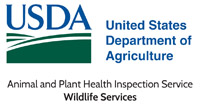U.S. Department of Agriculture: Animal and Plant Health Inspection Service

United States Department of Agriculture Wildlife Services: Staff Publications
Document Type
Article
Date of this Version
6-1-2021
Citation
Wildlife Society Bulletin 45(2):237–243; 2021;
DOI: 10.1002/wsb.1177
Abstract
Wildlife-aircraft collisions (wildlife strikes) pose a serious safety risk to aircraft. Raptors (i.e., hawks and owls) are one of the most frequently struck guilds of birds within North America. Although raptors (most notably red-tailed hawks [Buteo jamaicensis]) are commonly managed at most airports and military bases, there is no scientific information available regarding comparisons of the efficacy of raptor management programs for reducing raptor-aircraft collisions. Therefore, we conducted a study to examine the efficacy of 2 raptor hazard management programs implemented at Chicago's O'Hare International Airport (ORD). The first raptor management program (Phase I) occurred during January 2010–June 2013 and was characterized by intensive and sustained live-trapping and translocation efforts. The second raptor management program (Phase II) occurred during July 2013–December 2016 and involved live-trapping and translocation of specific age classes and increased lethal removal of problematic individual hawks. Compared with Phase I, there were 47% fewer red-tailed hawk strikes (52 in Phase I and 28 in Phase II) and 67% fewer damaging red-tailed hawk strikes (6 in Phase I and 2 in Phase II) during Phase II of the management programs. Our findings demonstrate that airport wildlife management decisions based on scientific data and biological information can aid in reducing wildlife strikes, financial losses, and ultimately airport liability while increasing human safety. The decision matrix regarding the components of an airport raptor hazard management program involves a variety of biological, geographic, logistical, economic, and socio-political variables. Our study provides a scientific foundation for informing such management decisions. Published 2021. This article is a U.S. Government work and is in the public domain in the USA.
Included in
Natural Resources and Conservation Commons, Natural Resources Management and Policy Commons, Other Environmental Sciences Commons, Other Veterinary Medicine Commons, Population Biology Commons, Terrestrial and Aquatic Ecology Commons, Veterinary Infectious Diseases Commons, Veterinary Microbiology and Immunobiology Commons, Veterinary Preventive Medicine, Epidemiology, and Public Health Commons, Zoology Commons


Comments
This article is a U.S. Government work and is in the public domain in the USA.